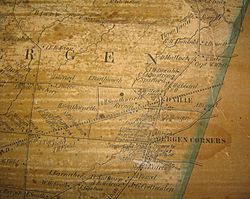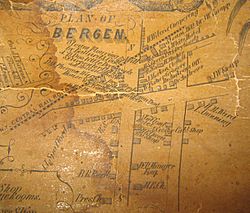Bergen (village), New York facts for kids
Quick facts for kids
Bergen, New York
|
|
|---|---|
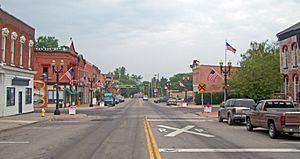
Looking north along Lake Street (NY 19) to railroad crossing
|
|
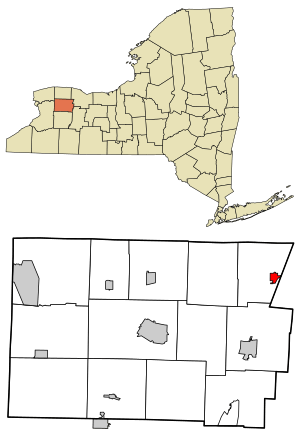
Location in Genesee County and the state of New York.
|
|
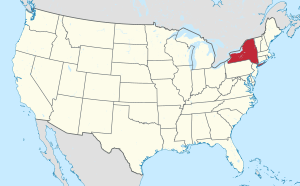
Location of New York in the United States
|
|
| Country | United States |
| State | New York |
| County | Genesee |
| Settled | 1801 |
| Incorporated | 1877 |
| Named for | Bergen, Norway |
| Government | |
| • Type | Village Hall |
| Area | |
| • Total | 0.74 sq mi (1.91 km2) |
| • Land | 0.74 sq mi (1.91 km2) |
| • Water | 0.00 sq mi (0.00 km2) |
| Elevation | 606 ft (185 m) |
| Highest elevation
(In S corner of village)
|
665 ft (203 m) |
| Population
(2020)
|
|
| • Total | 1,208 |
| • Density | 1,639.08/sq mi (633.21/km2) |
| Time zone | UTC-5 (EST) |
| • Summer (DST) | UTC-4 (EDT) |
| ZIP Code |
14416
|
| Area code(s) | 585 |
| FIPS code | 36-06046 |
| GNIS feature ID | 0943720 |
Bergen (pronounced BUR-jən) is a small village in Genesee County, New York, United States. In 2020, about 1,208 people lived there.
The village is located on the eastern side of the larger town of Bergen. It sits just north of where two main roads, Route 19 and Route 33, meet.
Contents
History of Bergen Village
The area around Bergen was first opened up in 1801. A new road was built through the thick "Northwoods" forest. This road connected LeRoy to Lake Ontario. In its earliest days, Bergen was even called "Northwoods."
Early Settlers and Growth
The first person to settle in Bergen was Samuel Lincoln in 1801. Other families, like the Letsons and Wordens, also arrived that same year. Between 1805 and 1810, about 60 families from Connecticut moved to the area. They settled along Route 19, from Fort Hill to Black Creek.
The first store opened about a mile south of Route 33 on Route 19. An area called "Buell's Corner" became the first group of stores. This spot was later known as "Bergen Corners" or "High Bergen." The first church group started in 1807, and the Congregational church was founded in 1808. Harry Kelsey, a Yale College graduate, taught the first school.
The Railroad Arrives
In 1836, a railroad line came through Bergen. This led to a new area being developed around the intersection of Lake Road (Route 19) and the railroad tracks. This new section was called "Wardville," named after the Levi Ward family who planned it. It was also known as "Cork" because many Irish people settled there while building the railroad. People also called it "Lower Bergen."
Soon, homes and churches connected the two areas, "High Bergen" and "Lower Bergen."
Fires and Rebuilding
Fires were a big problem in Bergen's early days. The business area near the railroad tracks was destroyed by fire in 1866.
On March 5, 1877, the village of Bergen was officially "incorporated." This meant it became its own local government. The village was located near the center of the eastern border of the town, along the New York Central and Hudson River Railroad.
Another fire destroyed the business area around the railroad tracks in 1880. After this, the Village Board made a rule. All new buildings in that area had to be made of brick, stone, or strong iron. This helped make the buildings safer.
The west side of the business district, south of the railroad, is now on the National Register. It's called the Lake Street Historic District. This is because of its unique 1880 iron storefronts and the important Ward family who helped found the area.
Even with better building materials, fires still happened. A fire in 1906 damaged some buildings on the west side of the street. In 1932, another fire destroyed some buildings on the east side. Since then, smaller fires have caused changes to some building fronts.
Geography of Bergen
The village of Bergen is in the northeastern part of Genesee County. It covers about 0.74 square miles (1.91 square kilometers) of land. There is no water within the village limits.
Roads and Connections
New York State Route 19 goes right through the village center. It's called Lake Avenue there. This road goes north about 9 miles to Brockport and south about 8 miles to Le Roy.
New York State Route 33 runs along the southern and eastern edges of the village. It leads northeast about 3 miles to Churchville and 19 miles to Rochester. To the southwest, Route 33 goes about 14 miles to Batavia.
New York State Route 262 goes west from Bergen about 13 miles to Elba. Also, Interstate 490 is just southeast of Bergen. You can get on it from exit 2 (NY Route 33A). This interstate leads northeast into Rochester. It also connects to Interstate 90, which is part of the New York State Thruway.
Waterways
All the water in the village area flows north into Black Creek. Black Creek is a smaller stream that flows east and eventually joins the Genesee River.
Bergen's Population
| Historical population | |||
|---|---|---|---|
| Census | Pop. | %± | |
| 1850 | 250 | — | |
| 1860 | 150 | −40.0% | |
| 1880 | 675 | — | |
| 1890 | 623 | −7.7% | |
| 1900 | 624 | 0.2% | |
| 1910 | 637 | 2.1% | |
| 1920 | 576 | −9.6% | |
| 1930 | 724 | 25.7% | |
| 1940 | 658 | −9.1% | |
| 1950 | 786 | 19.5% | |
| 1960 | 964 | 22.6% | |
| 1970 | 1,018 | 5.6% | |
| 1980 | 976 | −4.1% | |
| 1990 | 1,103 | 13.0% | |
| 2000 | 1,240 | 12.4% | |
| 2010 | 1,176 | −5.2% | |
| 2020 | 1,208 | 2.7% | |
| U.S. Decennial Census | |||
According to the census in 2000, there were 1,240 people living in Bergen. There were 466 households, and 317 of them were families. The village had about 2,002 people per square mile (770 people per square kilometer).
About 35% of the households had children under 18 living with them. Most households (57.5%) were married couples living together. About 24% of all households were individuals living alone.
The population was spread out by age. About 29% were under 18 years old. About 33% were between 25 and 44 years old. And about 9% were 65 years or older. The average age in the village was 35 years.
The average income for a household in the village was about $51,016 per year. For families, the average income was around $54,327. About 3.6% of all people in the village lived below the poverty line. This included 4.8% of those under 18 and 7.1% of those 65 or older.
See also
 In Spanish: Bergen (villa) para niños
In Spanish: Bergen (villa) para niños


